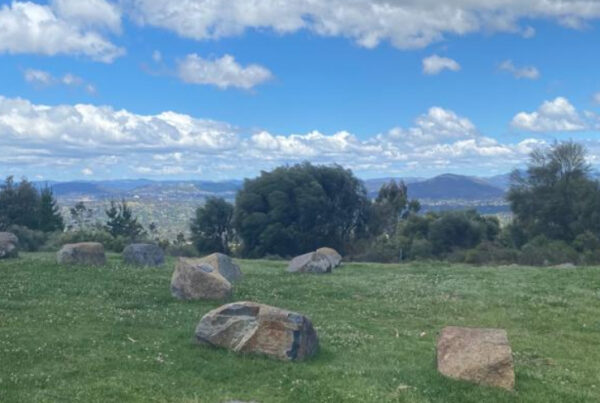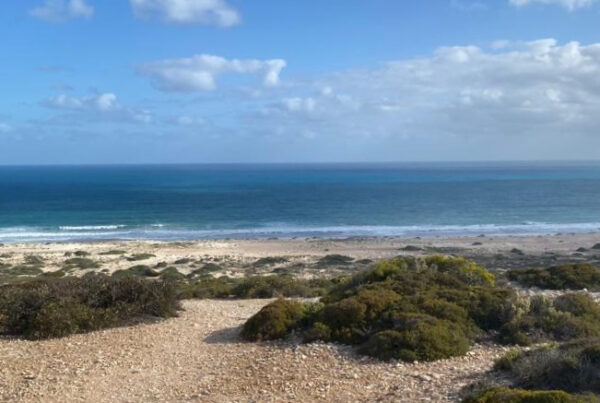With the Charge Around Australia challenge to drive an electric vehicle, powered by solar energy, around the entire 9,380 miles (15,097km) of Australia’s coastline starting next month, our project director Stuart McBain flew out to Melbourne in July to take part in a week-long test drive.
The primary aim of the test drive was to establish how best to organise and run STEM roadshow school visits safely and successfully, as well as to confirm the most efficient way of rolling out and setting up the solar sheets for harvesting energy from the sun. We have 18 solar sheets for use on the Charge Around Australia drive, but only took four out on the test drive in order to try out different material and wiring configurations.
Dress rehearsal drive
After flying into Melbourne, Stuart made a beeline to pick up the Tesla 3 electric car – organised via Evee – that we’re using for Charge Around Australia. His first trip was the short journey to meet up with Mark Tipping, president of the Tesla Owners Club of Australia. Having recently completed a half lap of Australia in his own electric vehicle, Mark was able to offer Stuart invaluable advice ahead of the upcoming drive, from charging infrastructure details to strategies for avoiding potential problems.
Next stop was the University of Newcastle to meet up with the CAA team. Ben Vaughan and Dr Nicholas Nikolaidis from the university’s Centre for Organic Electronics joined Stuart out on the road for the six days of the test drive. They led the way in the support vehicle, towing the trailer, while Stuart followed behind in the electric vehicle.
The first roadshow stop on the test drive was Kotara South Public School, just a 10-minute drive from the university. The day featured Stuart’s introductory talk about the project’s solar sheets and epic drive, Nick’s interactive science experiments and computer games to raise awareness of the importance of renewable energy sources, and Ben’s workshop to make a credit card-sized solar panel from its components. All the activities went well with the students engaged and interested.
After wrapping up the activities, everyone came together for a live link with the university so the team there could demonstrate the printing process and explain how the solar sheets being used for the project are actually made. This order of events was established as the schedule for all the subsequent roadshow school visits.
The next stop was a two-hour drive away at Merriwa Central School. Another highly successful visit, the team were able to hone the process of rolling out the solar sheets for energy harvesting and setting up the roadshow activities in only 45 minutes.
The town of Merriwa is famous for its pies, which the team can now vouch for, having been able to sample some delicious baked goods during their visit! Stuart also learned his first Australian acronym: COLA – meaning ‘covered outdoor learning area’.
Another two hours along the Golden Highway brought the CAA team to Dubbo College Senior Campus for a rewarding roadshow. Two of the solar sheets were used at the college to harvest the required daily charge for 100 miles of driving. The sheets harvested solar energy for eight hours, but due to the impact of cloudy conditions on the time rate they had to gather solar energy for 10 hours the following day to ensure enough was harvested.
Our stop at Coonabarabran High School coincided with the weekend, meaning the visit was an open day with people dropping in to say hello and find out what the project is all about. The town of Coonabarabran and surrounding area are known for their clear skies, consequently the region is a national hot spot for astronomy. The site survey that the team carries out on arrival at each roadshow stop finds them gazing up to the skies each day to help figure out the best place to roll out the solar sheets in order to maiximise sunlight exposure, keeping in mind of course, that in the Southern Hemisphere the sun tracks the northern sky.
After a two-hour drive east to Tamworth, the team were able to relax during a well-earned rest day. At Calrossy Anglican School the following day, Stuart and Ben took part in a school assembly with the headmaster about the project, as well as carrying out interviews with local newspaper, the Northern Daily Leader, and for a national TV feature on Channel 7 News.
The final stop on the test drive was at Muswellbrook High School who kindly let us use their field to charge the electric vehicle, even though there were no students in the school for the roadshow activities. By this time the team were fully confident in efficiently rolling out the solar sheets and setting up the solar power harvesting system, which works as follows:
From the rolled out solar sheets run cables that are plugged into a patch panel in the trailer. This panel has a controller that shows how much energy is being harvested, displaying wattage and voltage levels. This energy is stored in a bank of batteries. An inverter converts the electricity from DC to AC and steps it up to 240 volts. An extension cable from a standard household connection, is plugged into the onboard Tesla charger, which when set at 15 amps charges the car at 20kmph.
Back to base
Having driven around 1,000km on the test drive, the team were driving back to the university on the last day to make some technical adjustments. They were 1km away, when all of a sudden, Stuart driving behind the support vehicle, saw a wheel nut ping off the nearside trailer wheel, which then started wobbling, before detaching from the trailer and rolling down the road for 200 metres.
The support vehicle had been travelling at around 40kmph, but fortunately no one was hurt by the rolling wheel. It turns out that only two of the six wheel nuts had been properly tightened and the others had worked themselves loose before the wheel finally came off. The two weeks needed to replace damaged axle mean that it should be ready just in time for the Charge Around Australia drive. Rest assured, on that three-month long drive we’ll be checking the trailer wheel nuts on a regular basis.
Ready to Charge Around Australia
Having completed a successful test drive the CAA team is more than happy. Understanding how the solar sheets perform in the real world is the measure of success. The university team’s research and development in printed solar has paid off – they know how the system works, have produced solar sheets, and have taken them out of the lab and into the world.
We can safely say that the Charge Around Australia team is now the preeminent global authority on the deployment of printed solar sheets in the real world. Next stop – the entire coastline of Australia!





